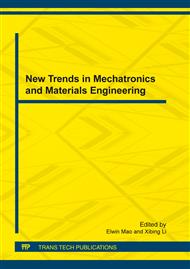[1]
Dexi Wang. The study on Coaxial Shielded style permanent magnetic actuator [D], Northeastern University, 2000: 9.
Google Scholar
[2]
Wendy Lorimer, Albert Hartman. Magnetization pattern for increased coupling in magnetic clutches[J], 1997, 33(5): 4239-4241.
DOI: 10.1109/20.619722
Google Scholar
[3]
Jean-Frederic Charpentier, Guy Lemarquand. Optimal design of cylindrical air-gap synchronous permanent magnet couplig[J], IEEE Transactions on Magnetics, 1999, 35(2): 1037-1043.
DOI: 10.1109/20.748851
Google Scholar
[4]
P.Elies,Glemarquand. Analytical Optimization of a Permanent-Magnetic Coaxial Sychronous Coupling[J], IEEE Transactions on Magnetics, 1998, 34(4): 2267.
Google Scholar
[5]
Y. D. Theoretical computations for the torque of magnetic coupling, IEEE Transactions on Magnetics[J], 1995, 31(3): 1881-1884.
Google Scholar
[6]
E. P. Furlani. Formulas for the force and torque of axial coupling[J], IEEE Transactions on Magnetics, 1993, 29(2): 2522.
Google Scholar
[7]
Caio Ferreira, Jayant Vaidya. Torque analysis of permanent magnet coupling using 2D and 3D finite elements methods[J], IEEE Transactions on magnetics, 1989, 25(4): 3080-3082.
DOI: 10.1109/20.34375
Google Scholar
[8]
Eugene A. Aronson, John R. Brauer. Magnetic torque of force calculation by direct differentiatton of finite element coenergy[J], IEEE Transactions on magnetics, 1997, 25(5): 3578-3581.
DOI: 10.1109/20.42369
Google Scholar
[9]
Pill-Soo Kim, Yong Kim, Soo-Hyun Back. 2-D Analysis of magnetizing fixture for stator magnet of air-cleaner DC motor[J], ISPMM 95, 1995, 1154-1157.
Google Scholar
[10]
Y. D. Yao. Magnetic coupling studies between radial magnetic gears[J]. Transactions on Magnetics, 1997, 33(5): 4236-4238.
DOI: 10.1109/20.619721
Google Scholar
[11]
A. Layadi. Determination of magnetic coupling from torque curve, Journal of magnetism and magnetic materials[J], 1999, (192) : 353-362.
DOI: 10.1016/s0304-8853(98)00391-6
Google Scholar


